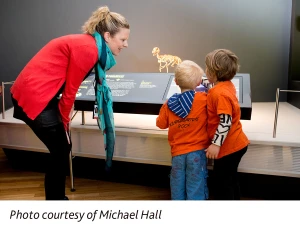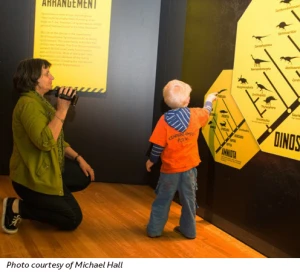University of Waikato: Margaret Carr, Bronwen Cowie, and Jeanette Clarkin-Phillips
Te Kōhanga Reo me Te Kura Kaupapa Māori o Mana Tamariki: Brenda Soutar
Project Dates: 2014 - 2017
Partnerships: Te Kōhanga Reo me Te Kura Kaupapa Māori o Mana Tamariki

This project builds on young children’s creative inclinations to puzzle about the unknown, develop innovative working theories and to expect (and enjoy) difference. This innovation potential is a precious natural resource that is threatened in a world of readily packaged information. However, a museum visit provides a unique design space that can protect and strengthen learner qualities such as: asking and pursuing questions; calling on prior knowledge to make innovative connections across different disciplines, places and times; and taking risks to articulate a viewpoint and imagine alternatives.
Building on pilot research work, this project will, in the first instance, focus on boundary objects and conversations as mediating tools. In a series of iterative design experiments it will explore the ways in which—in different cultural sites—these tools enable the identification and the strengthening of creative capacities during a well-designed museum visit. The project will research visits to museums by young children and teachers from early childhood centres, school classrooms, kōhanga reo and kura kaupapa Māori. The mapping of creative responses across all sites will create cross-cultural spaces for dialogue. Collaborative discussions will aim to construct a cultural analysis of creative dispositions that will challenge international monocultural definitions and protocols.
Why is this research important?

Museums have traditionally had an information sharing purpose: to capture the interest of visitors and add to their knowledge of other lives, places and times. This research builds on young children’s creative inclinations to puzzle about the unknown, develop innovative working theories and to expect and enjoy the difference. It is exploring whether a well-designed museum visit can provide opportunities for nurturing innovation and the creative capacities of young people. It is distinctive in that it is researching visits to museums by young children and teachers from early childhood centres, school classrooms, kōhanga reo and kura kaupapa Māori.
What is the background to the project?
The project developed from earlier research projects funded by the Ministry of Education (a Centres of Innovation programme and a Teaching & Learning Research Initiative project). In those projects we explored the ways in which children were interacting with museum collections and artifacts, and we became especially interested in the role of resources that crossed the boundary between the museum and the education site.
What are the key findings to date?
In pursuit of their own meaning-making purposes and interests children often reconfigure and extend the official messages that the exhibitions of taonga (treasures) are designed to communicate. In our project, children are taking advantage of a museum’s potential to serve as a centre of creativity: a site for mingling together old and new ideas. Meanings are expressed by the children in a range of communication modes. These responses are afforded by: dialogue and the use of resources (e.g. sketch books) during the visit, preparation in the education site prior to the visit, together with discussions and work after the visit. The children’s responses are personal and idiosyncratic, often – explicitly or implicitly – calling on prior knowledge, interests, dispositions and experience. The project is developing an array of evidence-based creative capacity elements that it is possible to aspire to when young children visit a museum. The two contexts – te reo Māori and English language - are enabling us to construct a cultural analysis of creative disposition that will challenge mono-cultural definitions and protocols.
What are the most important facts to take away so far?
In the contexts for this project, tamariki/children, kaiako/teachers and taonga/artifacts each collaborate with the other to add creative capacity building to information-gathering. Our highlighting of the features of these combinatory museum encounters will contribute to national and international literature and pedagogy in this domain.